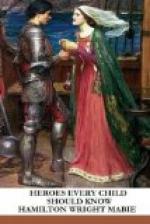It was during this trouble that Alfred stayed in the hut of a neatherd or swineherd of his, who knew who he was, though his wife did not know him. One day the woman set some cakes to bake, and bade the King, who was sitting by the fire mending his bow and arrows, to tend them. Alfred thought more of his bow and arrows than he did of the cakes, and let them burn. Then the woman ran in and cried out, “There, don’t you see the cakes on fire? Then wherefore turn them not? You are glad enough to eat them when they are piping hot.”
We are told that this swineherd or neatherd afterwards became Bishop of Winchester. They say that his name was Denewulf, and that the King saw that, though he was in so lowly a rank, he was naturally a very wise man. So he had him taught, and at last gave him the Bishoprick.
I do not think that I can do better than tell you the next happening to Alfred, as it is in the Chronicle, only changing those words which you might not understand.
“And that ilk [same] winter was Iwer’s and Healfdene’s brother among the West-Saxons in Devonshire; and him there men slew and eight hundred men with him and forty men of his host. And there was the banner taken which they the Raven hight [call]. And after this Easter wrought King Alfred with his little band a work [fortress] at Athelney, and out of that work was he striving with the [Danish] host, and the army sold [gave] him hostages and mickle oaths, and eke they promised him that their King should receive baptism. And this they fulfilled. And three weeks after came King Guthrum with thirty of the men that in the host were worthiest, at Aller, that is near Athelney. And him the King received at his baptism, [Footnote: That is, was his godfather.] and his chrisom-loosing [Footnote: That is, he laid aside the chrisom or white garment which a newly baptised person wore.] was at Wedmore. And he was twelve nights with the King, and he honoured him and his feres [companions] with mickle fee [money].”
Thus you see how soon King Alfred’s good luck came back to him again. The Raven was a famous banner of the Danes, said to have been worked by the daughters of Ragnar Lodbrog. It was thought to have wonderful powers, so that they could tell by the way in which the raven held his wings whether they would win or not in battle.
You see the time of utter distress lasted only from soon after Twelfth-night to Easter, and even during that time the taking of the Raven must have cheered the English a good deal. After Easter things began to mend, when Alfred built his fort at Athelney and began to skirmish with the Danes, and seven weeks later came the great victory at Ethandun, which set Wessex free. Some say that the white horse which is cut in the side of the chalk hills near Edington was cut then, that men might remember the great battle of Ethandun. But it has been altered in modern times to make it look more like a real horse.




